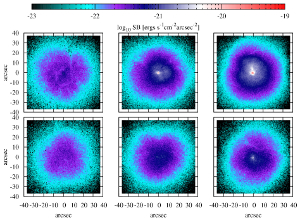|
|  |
Lyman-alpha emitters (LAEs) are a group of galaxies emitting a
significant fraction of their radiation at wavelengths around 121.567
nm, the so called Lyman-alpha line of hydrogen. As this is more easily
detectable for far-away objects, where the line has been shifted away
from its original UV-wavelength to optical light, this property has
been used to specifically detect LAEs at high redshifts (up to z=8),
when our Universe was less than a billion years old.
However, life is complicated for these Lyman-alpha photons at very
high redshifts (z>6). The gas in the inter-galactic medium (IGM)
around these galaxies tends to be more and more neutral, leading to
increased scattering. Just like fog scatters and dims the headlights
of a car, the neutral hydrogen atoms make the LAEs fainter and
eventually too faint for detection. On the other hand, this effect can
be used to understand the changes in the IGM from a neutral to a
highly ionized state known as the epoch of reionization.
The probability of scattering is highest when the wavelength of the
photon is closest to the original wavelength of the Lyman-alpha
line. As the photon travels (unscattered) towards the observer, it
becomes red-shifted towards longer wavelengths due to cosmic
expansion. Therefore, the IGM closest to the galaxy has the highest
impact on Lyman-alpha photon scattering.
The details of this scattering depend on various properties of the
hydrogen in the gas, in particular its density, velocity and level of
ionization. Moreover, inhomogeneities in the IGM (see Fig. 2) could
significantly affect the radiative transfer of the Lyman-alpha
photons.
Scientists at MPA performed a new study of this effect, combining
detailed cosmological simulations of the IGM close to the galaxy with
radiative transfer calculations of the Lyman-alpha radiation. Their
analysis shows that the scattering behaviour of Lyman-alpha photons is
extremely complex with large variations along different lines of sight
(see Fig. 3). The LAEs appear not as point sources but as extended
haloes with complex structure and the total Lyman-alpha flux can vary
by a factor of 3 for the same object, depending on the line of
sight. This makes it difficult to link the Lyman-alpha flux to galaxy
properties.
An additional complication arises from the detection threshold of
observation campaigns. Depending on the depth of an observational
survey, only some of the pixels of the surface brightness profile will
be above the detection threshold. However, due to the structure in the
IGM and the scattering of Lyman-alpha photons, the flux arriving in
each pixel of an LAE imaging campaign can vary by several orders of
magnitude. This means that only a fraction of the total flux along
this particular line of sight would be detected and assigned to the
LAE - only the tip of the iceberg actually shows.
Towards higher redshifts, achieving deep detection thresholds becomes
increasingly harder, which contributes to the effective dimming of
LAEs in these observational campaigns. This in turn would affect the
estimation of the IGM neutral fraction using the detection of LAEs in
observational surveys.
Thus this study emphasises the need for deep observations of the LAEs
as well as detailed 3D radiative transfer simulations to properly
model these objects. Only then can they be used as accurate probes to
study the distant universe and the epoch of reionisation.
Akila Jeeson-Daniel, Benedetta Ciardi, Umberto Maio, Marco Pierleoni,
Mark Dijkstra, Antonella Maselli
Original publication
Akila Jeeson-Daniel, Benedetta Ciardi, Umberto Maio, Marco Pierleoni,
Mark Dijkstra, Antonella Maselli,
“Effect of Intergalactic Medium on the Observability of Lyman Alpha
Emitters during Cosmic Reionization”,
accepted for publication in MNRAS.
 http://arxiv.org/abs/1204.2554 http://arxiv.org/abs/1204.2554
|


